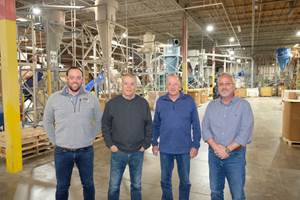EXTRUSION: Managing Regrind
Reusing scrap is a necessary evil. But be aware of the negative impact scrap has on properties and extrusion efficiencies. Start by developing a regrind-usage program.
All extrusion operations generate some scrap, even if it’s just a little from trim and at startup. Sheet extrusion/thermoforming lines can yield as much as 60% scrap, while some bag operations can generate 20% scrap even when running at high levels of efficiency.
Reuse of this scrap is economically necessary, but it’s also important to understand the effect scrap has on the loss of product properties and increased processing adjustments caused by the changing extrusion properties. Polymers experience various degrees of degradation each time they pass through an extruder. The molecular weight is gradually reduced by the repeated processing, which breaks the polymer chains either through shear forces or chemical changes from heating.
Molecular weight, or length of the polymer chains, accounts for many of the physical properties of the material, such as tensile strength, impact strength, and modulus. The higher the initial molecular weight, the greater the early loss in properties during processing.
Moreover, many additives such as antioxidants, processing aids, stabilizers, and impact modifiers are depleted during repeated processing, which further accelerates the rate of polymer degradation. Finally, the degradation of the regrind through repeated processing affects the efficiency of the extrusion operation. Drawdown, die flow, melt strength, and even melting rate in the screw are affected by the drop in molecular weight.
In processes where large percentages of regrind are generated continuously, some portion of the polymer may literally experience hundreds of processing cycles, degrading it to the point of being unusable without addition of virgin polymer to restore some of the lost properties. To minimize this issue, processors should develop a regrind-usage program that will try to utilize the normal percentage of regrind generated in each operation on a daily basis. This keeps inventories low and reduces the average number of processing cycles in the regrind.
To do that, the “normal” level of regrind generation must first be determined. That determination takes some effort, requiring measurement of the virgin and regrind being used on a daily basis for at least one month, compared with the shipments, as well as any increase or decrease in regrind inventory. This will provide a good estimate of the “normal” level of regrind generation.
Once that is determined, the extrusion lines can be be set up to use the normal amount of regrind on a fixed basis. That may require a series of simple operating adjustments, or could even require some changes in equipment, such as screw or die design. After a month of operation on that basis, further tweaking of the regrind percentage can be made, depending on whether regrind levels are being accumulated or consumed. Any major upsets during this evaluation period must of course be discounted to achieve an accurate “normal.” Upsets that suddenly increase the amount of scrap above the norm have to be accounted for with either special processing trials or various other means so that the consistency remains the same as soon as the upset is corrected.
Consistent regrind percentages in your product will stabilize physical properties as well as color, gloss, and transparency, making for reduced scrap and returns. Typically the higher the percentage of regrind usage and/or its variability, the higher the scrap rate. When the regrind percentage is constantly changing, operators are continuously required to change temperatures, die adjustments, and downstream parameters to hold product geometry and quality, leading again to higher scrap rates.
Consistent usage of regrind percentages pays off quickly and in significant amounts. Maintaining as close to the normal generation level with constant percentages of usage not only improves processing consistency and product quality but tends to minimize further generation of more scrap.
Processing the polymer into scrap costs even more than processing saleable product because of the additional handling and regrinding costs. It can also affect requirements for capital investment in grinding equipment and storage facilities. If a stable regrind generation level cannot be developed, then there are equipment or operating issues that need to be addressed so a stable level can be achieved.
ABOUT THE AUTHOR
Jim Frankland is a mechanical engineer who has been involved in all types of extrusion processing for more than 40 years. He is now president of Frankland Plastics Consulting, LLC. Contact jim.frankland@comcast.net or (724)651-9196.
Related Content
NPE2024 Wrap-Up: Sustainability Dominates Show Floor News
Across all process types, sustainability was a big theme at NPE2024. But there was plenty to see in automation and artificial intelligence as well.
Read MoreSkipping the Pellet for Efficient Recycling in Molded Engineering Plastics Applications
AGS Technology leverages deep experience in molding with recycled engineering materials for automotive and heavy equipment parts.
Read MoreInside the Florida Recycler Taking on NPE’s 100% Scrap Reuse Goal
Hundreds of tons of demonstration products will be created this week. Commercial Plastics Recycling is striving to recycle ALL of it.
Read MoreEvolving Opportunities for Ambitious Plastics Recycler
St. Joseph Plastics grew from a simple grinding operation and now pursues growing markets in recycled PP, food-grade recycled materials, and customized post-industrial and post-consumer compounds.
Read MoreRead Next
For PLASTICS' CEO Seaholm, NPE to Shine Light on Sustainability Successes
With advocacy, communication and sustainability as three main pillars, Seaholm leads a trade association to NPE that ‘is more active today than we have ever been.’
Read MorePeople 4.0 – How to Get Buy-In from Your Staff for Industry 4.0 Systems
Implementing a production monitoring system as the foundation of a ‘smart factory’ is about integrating people with new technology as much as it is about integrating machines and computers. Here are tips from a company that has gone through the process.
Read MoreLead the Conversation, Change the Conversation
Coverage of single-use plastics can be both misleading and demoralizing. Here are 10 tips for changing the perception of the plastics industry at your company and in your community.
Read More.jpg;width=70;height=70;mode=crop)












